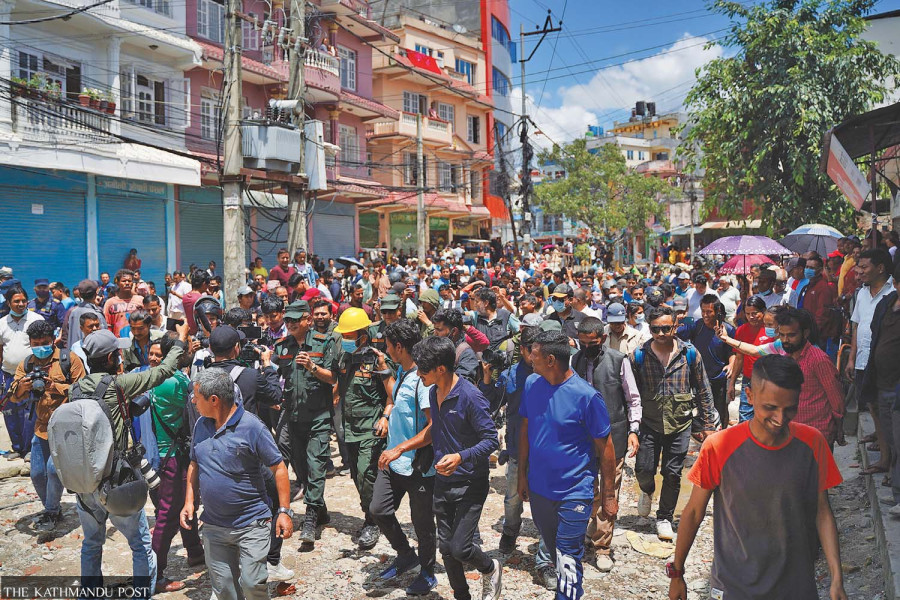Kathmandu
Kathmandu metropolis’ drive to remove slabs from a border brook hits snag
After Samakhusi, the Kathmandu municipal police reached Tokha, where they were confronted by local residents and people’s representatives, who say the demolition drive would cause more trouble.
Anup Ojha
The body of the boy who went missing after being swept away in a flash flood in a local stream of the Samakhusi river in Kathmandu was discovered on August 3, nearly two weeks after the mishap.
On July 23, the flash flood breached the embankment and swept away the sixth-grader, Sajan Ale Magar.
The incident not only troubled the police, it also worried Samakhushi locals, who said they fear their children might be the next victims.
Police and locals said if only the river was not covered with slabs it would not have been that hard to get the body of the boy. However, the 11-year-old boy’s body was found on the 11th day of the search, from Bagmati river in Dakshinkali Municipality-7.
Shortly after the incident, the Kathmandu Metropolitan City (KMC) started to take off the slabs from the brook, from the bridge near the Police Beat in ward-3 to ward-36, close to Rehdon College.
Officials said as much as 80 percent of the streams flowing into the Samakhusi river was covered with slabs.
According to KMC’s spokesperson, by Thursday, the City had taken off slabs from the river from an area of nearly 2.5 km.
Although KMC said it did a commendable job of opening the river which will help them in taking back the encroached land of the river, the locals say KMC worked hastily in removing the slabs.
People seem to be divided over the job performed by the KMC. While some are supporting KMC for claiming the encroached land of the river, others are saying KMC’s work is not justifiable.
“The KMC’s intention is good, but the timing is wrong,” said Chandra Bagale, 43, a local grocery shop owner.
“The rainy season is not yet over, and the KMC has not kept any fencing on the river side. Roads and houses are very close to it, so there is a greater chance of more children falling into it.”
KMC's spokesperson Nabin Man Manandhar said his office is working toward fencing the river on both sides. “We need to go for the beading process, which may take a few months,” said Manandhar.
He, however, said people need not worry, as the rainy season is almost over.
After clearing the slabs along the Samakhusi brook, the KMC city police on Thursday reached Kapan to remove the slabs from the brook that falls between KMC ward number 10 and Budhanilkantha Municipality ward number 7. A team led by Deputy Inspector Minbahadur Thapa had reached there to demolish the slabs and a few squatter settlements with an excavator, but due to protests by the locals and representatives of the Budhanilkantha Municipality, the KMC City police had to back off.
The incident at the Samakhusi river is not an isolated case. In September 2021, 10-year-old Ujjwal BK fell into an open drainage in Kapan. The boy’s body was found in Lalitpur after five days.
“We are very concerned about our place, but the KMC police used force on our representatives,” said Mitharam Adhikari, mayor of Budhanilkantha Municipality.
He said two of his municipality staff—ward-10 chair Navaraj Maharjan and Rita Dahala, executive member of the Budhanilkantha Municipality—were injured after KMC’s police used force.
“The rainy season is still not over. If we open the brook’s slab, it would create more trouble,” said Adhikari. “The main problem with the Kathmandu Valley is that all the cultivable land has been turned into concrete, and there is no soil left for water recharge. This has created inundation problems.”
He said his municipality is ready for talks with the KMC. “But the KMC should have consulted us before it brought in the City police and used force upon our people,” he said.




 16.57°C Kathmandu
16.57°C Kathmandu.jpg)










